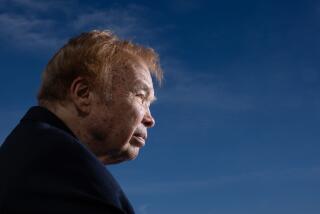Eli Broad’s proposed art museum; ‘the pill’ and its impact; observing the Sabbath
- Share via
Backing for Broad
Re “Museum plan is in eye of the beholder,” April 30
With the local economy locked in the grip of a deep recession, it is unfortunate that some find fault in Eli Broad’s generous offer to pay for the construction of a world-class museum, donate a 2,000-piece art collection and fund its endowment for a cool $200 million.
What’s not to like? Broad’s long-standing commitment to Los Angeles’ cultural assets have secured L.A.’s enviable position on the world’s cultural map.
Investing in the city’s core improves the entire Los Angeles County economy because tourism is our No. 1 industry. Los Angeles desperately needs more civic leaders like Broad — visionary individuals who understand that a city without a great downtown is a city without a heart.
Carol E. Schatz
Los Angeles
The writer is president and CEO, Central City Assn. and Downtown Center Business Improvement District.
The Times reports on the proposal to facilitate the building of a new museum on Grand Avenue by Eli Broad. We at the Music Center, Los Angeles Philharmonic and LA Opera support this project enthusiastically.
In 1964, a downtown renaissance was set in motion by the creation of the Music Center. In the 1980s, MOCA planted its flag; then came the Cathedral, the Colburn School, the Walt Disney Concert Hall and a fabulous new arts high school.
The commercial developments along Grand Avenue were inspired by the presence of world-class art and architecture — and the millions of visitors and international attention that they attracted.
The proposed Broad museum is on the table at a time when the recession has stalled, if not crushed, all the plans for development on the parking lots on Grand Avenue.
The new museum, funded by Broad, has the potential to create an important cultural institution for Los Angeles and downtown, and to reignite residential and commercial development.
County, city and CRA officials are right to recognize that it is in the best interests of the community to work with Broad to make this happen.
John B. Emerson
Chairman, Music Center of Los Angeles County
David Bohnett
Chairman, Los Angeles Philharmonic
Marc I. Stern
Chairman and CEO, LA Opera
Stephen D. Rountree
President and CEO, Music Center of Los Angeles County
Deborah Borda
President, Los Angeles Philharmonic
Placido Domingo
General Director, LA Opera
Gustavo Dudamel
Music Director, Los Angeles Philharmonic
If Rupert Murdoch were proposing to spend upwards of $100 million of his own wealth to construct a gold-plated B-52 memorial to John Wayne in glorious downtown Newhall, I’d have full confidence that Los Angeles County Supervisor Michael Antonovich would be completely willing to lease land for a buck a year for 99 years.
John Crandell
Sacramento
Broad is a great philanthropist, donating much of his wealth to good causes. But we all have egos. Using city property to house his art collection plays to his ego. Why not just donate his collection to MOCA or LACMA?
At a time when Los Angeles desperately needs revenue to avoid further cuts in services and layoffs, this is not the time to give property away practically for free. Why can’t Broad buy land on the Westside and build his museum there?
As for the $200 million for his proposed endowment to cover the proposed museum’s operating costs, why not donate that to the schools to encourage education in the arts?
George Epstein
Los Angeles
Small pill, big impact
Re “ ‘The pill’: 50 years after,” May 4
Apart from a 40% to 50% reduction in the incidence of ovarian and uterine cancers, here are some of the many other conditions that may be lessened by “the pill”: ectopic pregnancy; painful menstruation; symptoms of menopause; fibrocystic breast disease; benign ovarian cysts; uterine fibroids; endometriosis; pelvic inflammatory disease (a cause of infertility); colorectal cancer; rheumatoid arthritis; iron-deficiency anemia; and duodenal ulcers.
Using “the pill” is much safer than becoming pregnant. Contrary to common wisdom, barrier methods such as condoms are not safer. Among 15- to 19-year-old women who rely only on condoms for contraception, between 1 and 3 in 100,000 will die. The reason is that the pregnancy rate is higher for condoms than for oral contraceptives.
The FDA’s position is that only women who need contraception should be prescribed oral contraceptives. However, given the substantial non-contraceptive benefits and relatively low risk in nonsmoking women, an argument could be made that even lifelong virgins should consider taking them.
George Tyndall, MD
Los Angeles
Thank you for bringing attention to the fact that use of “the pill” has not decreased the number of unplanned pregnancies in this country and that its efficacy is worse than that of IUDs.
I’m very lucky that in all my years of using the pill, I never had an unintended pregnancy; as a younger woman, I was not very diligent in taking it every day.
The new IUDs are safe and completely and easily reversible.
I’ve made it my mission to educate all of my friends and family and any other woman who will listen about the great advantages of the IUD. It’s made my life so much easier and less stressful.
Tina Studier
El Segundo
All work and no Sabbath
Re “Never off the clock,” Opinion, May 2
Judith Shulevitz’s Op-Ed about the Sabbath was very timely, given the near 24/7 schedule many of us are on and the array of communication devices we all use. These make us more efficient and free up time, which some of us use to search out more devices.
Case in point: latimes.com has a link inserted in Shulevitz’s article that probably would cut into Sabbath rest: “Receive breaking news alerts on your mobile device.”
Seventh-day Adventists observe the Sabbath from sundown Friday to sundown Saturday each week, taking literally the Fourth Commandment to rest from the week’s work.
The day is remembered in congregational worship and often in serving the community and reflecting on God’s creatorship by spending time in nature, which California has in abundance.
We carry our mobile devices with us, though hiking in steep canyons may temporarily block or slow down breaking news alerts, calls, tweets and e-mails.
Betty Cooney
Glendale
The writer is communication director, Southern California Conference of Seventh-day Adventists.
I enjoyed reading Shulevitz’s article about the shrinking or disappearance of the Sabbath and its benefits.
I remembered the Sundays of my youth, when “blue” laws were in effect and the day was so quiet and so different from the weekdays — maybe too much so.
It also made me think about retirement. Having been retired for 21/2 years, every day becomes the Sabbath, and it is sometimes difficult to make peace with being able to choose to be active or rest each day.
I wouldn’t trade retirement for anything; at the same time, it does show me that decisions about work and leisure aren’t limited to the time one has a job.
Laurie E. Scher
West Hollywood
Education 101
Re “Race to the Top II,” Editorial, May 4
It was encouraging to see The Times recognize that “making test scores a major factor in teacher evaluations” is among the “unproven ways to go about improving education.”
Perhaps this acknowledgement will begin the move away from demonizing teachers as the source of California’s education problems.
Paul Berry
San Marino
It’s just food
Re “Seed money,” May 2
Having grown up on the family farm, I’d never have imagined this so-called urban farming, where companies install and tend pricey “mini farms” in suburban backyards.
The farming I knew was hard work, with no fanfare. I don’t remember “dinner parties” in which anyone bragged that the food we ate was homegrown. Nothing special about that.
Timothy L. Wahl
Glendale
More to Read
The biggest entertainment stories
Get our big stories about Hollywood, film, television, music, arts, culture and more right in your inbox as soon as they publish.
You may occasionally receive promotional content from the Los Angeles Times.










